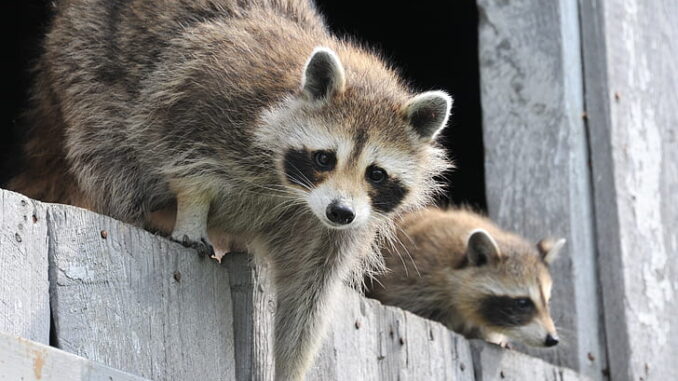
Do raccoons climb walls? The answer is yes! Raccoons are remarkable climbers, and their agility allows them to scale various surfaces, including walls. These furry creatures have sharp claws and strong limbs that make climbing walls seem like a walk in the park for them.
In this guide, we’ll delve into the fascinating world of raccoon climbing abilities, exploring the reasons behind their wall-scaling antics and how to address potential issues around your home.
Table of Contents
Do Raccoons Climb Walls?
Yes, raccoons are adept climbers and can scale walls with ease. They possess strong limbs with sharp claws that provide them with an excellent grip on various surfaces, including walls. Raccoons often climb walls in search of food, shelter, or to access elevated spaces.
Their climbing abilities make it possible for them to reach bird feeders, garbage cans, and other potential food sources.
Why Do Raccoons Climb Walls?
- Food Search: Raccoons often climb walls to access food sources, such as bird feeders or fruits on overhanging branches.
- Predator Escape: Climbing provides an escape route from ground predators, ensuring their safety.
- Shelter Exploration: Raccoons may climb walls to explore potential shelter locations, including attics.
- Territorial Exploration: Raccoons may climb walls to mark their territories or explore potential areas for foraging. Their climbing abilities contribute to their adaptability in urban and suburban environments.
Surfaces Raccoons Excel At Climbing:
- Trees: Raccoons effortlessly ascend trees, utilizing their sharp claws for secure grip.
- Fences: Wire and wood fences pose minimal challenges, allowing raccoons to traverse with ease.
- Walls: Concrete walls become raccoon playgrounds, showcasing their adaptability on both regular and irregular surfaces.
- Descents: Raccoons exhibit remarkable headfirst descents from trees, showcasing their climbing versatility. Raccoons are also capable of jumping vertically up to three feet and can leap horizontally over obstacles or gaps of similar height.
How to get rid of raccoons in the walls?
Dealing with raccoons nesting in your walls can be challenging, but taking prompt and effective measures by employing things raccoons hate can work out. Here’s a guide on how to get rid of raccoons in the walls:
- Identify Entry Points: Inspect and seal any gaps or openings where raccoons may be entering your home’s walls.
- Trim Overhanging Branches: Cut back tree branches that provide raccoons access to your roof and walls.
- Secure Garbage Bins: Ensure your garbage bins have tight-fitting lids to reduce potential food sources.
- Use Deterrents: Employ motion-activated lights, sprinklers, or ultrasonic devices to discourage raccoons.
- Apply Repellents: Utilize raccoon repellents, such as pepper spray, in areas where they might enter.
- Install Fencing: Consider installing fences designed to deter climbing around your property.
- Ammonia-Soaked Rags: Place ammonia-soaked rags near nesting areas to deter raccoons with a strong odor.
- Use Noise Devices: Create disturbances with loud music or noise devices near the walls to make the environment less appealing.
- Seek Professional Assistance: If issues persist, consult professional wildlife removal services for humane and effective solutions.
Why do raccoons jump against walls?
Raccoons may exhibit the behavior of jumping against walls for various reasons. One primary motivation is their innate curiosity and exploratory nature. Raccoons are known for their agility and problem-solving abilities, and jumping against walls allows them to investigate their surroundings, access higher vantage points, and potentially discover food sources or shelter.
Additionally, raccoons might engage in this behavior as a form of exercise or to communicate with other raccoons through vibrations and sounds. In urban environments, raccoons may jump against walls to navigate structures and adapt to their surroundings. While this behavior is generally natural for raccoons, homeowners should be vigilant about potential entry points and take measures to secure their properties to prevent raccoons from gaining access to sensitive areas.
Frequently Asked Questions (FAQs) About Raccoons Climbing Walls
Q1: Do raccoons make specific sounds when climbing walls, and what might these sounds indicate?
A: Yes, raccoons can produce distinct sounds when climbing walls, such as scratching or thumping. These sounds may suggest their presence, activity, or attempts to gain access to certain areas.
Q2: Can raccoons break through walls with their climbing abilities?
A: While raccoons are skilled climbers, they are generally not strong enough to break through walls. However, they may exploit existing vulnerabilities or openings to access enclosed spaces.
Q3: Can raccoons chew through walls, and how can homeowners prevent this?
A: Raccoons possess strong jaws and teeth, enabling them to potentially chew through weak or damaged areas of walls. Homeowners can mitigate this by promptly repairing any structural vulnerabilities and securing potential entry points.
Q4: Can raccoons climb up brick walls?
A: Yes, raccoons are adept climbers and can climb up brick walls with relative ease. Their strong limbs, sharp claws, and agility allow them to scale various surfaces, including brick, making it essential for homeowners to be aware of their climbing abilities and take preventive measures to secure potential entry points.
Q5: Are there surfaces that raccoons find challenging to climb?
A: Raccoons struggle to climb smooth vertical surfaces like glass and metals. Additionally, extremely thin poles and surfaces without proper grip pose difficulties for them.
Q6: Can raccoons climb both regular and irregular surfaces?
A: Absolutely, raccoons exhibit climbing versatility by effortlessly ascending both regular surfaces, such as trees and fences, and irregular surfaces like concrete walls.
Conclusion:
By comprehending raccoons’ climbing habits and taking preventive measures, homeowners can coexist with these agile creatures without encountering unwanted intrusions. Stay informed, secure entry points, and appreciate the marvel of raccoon adaptability.
